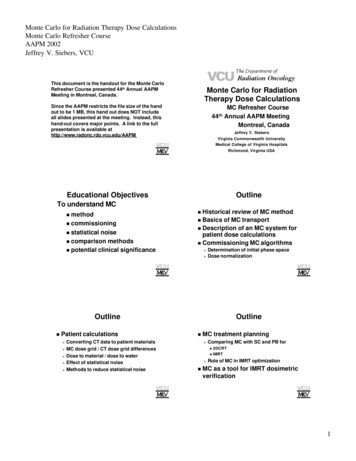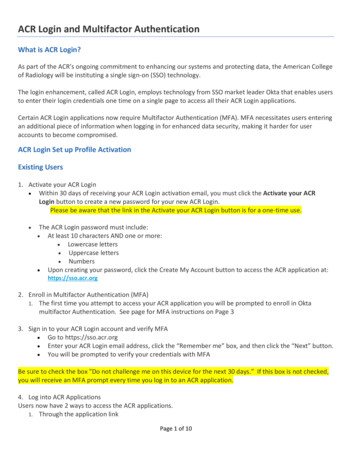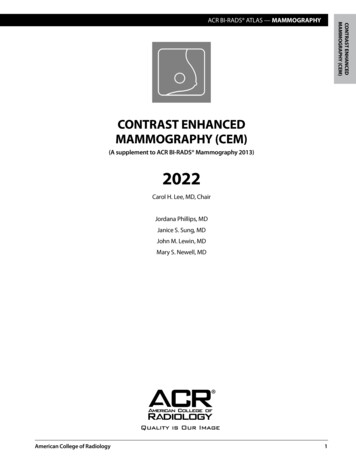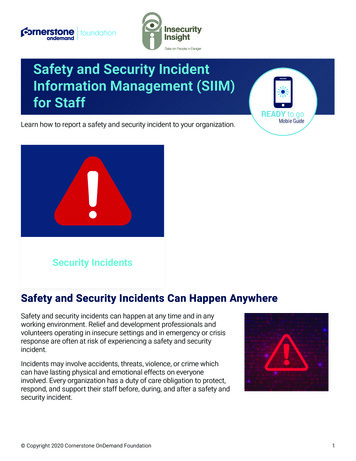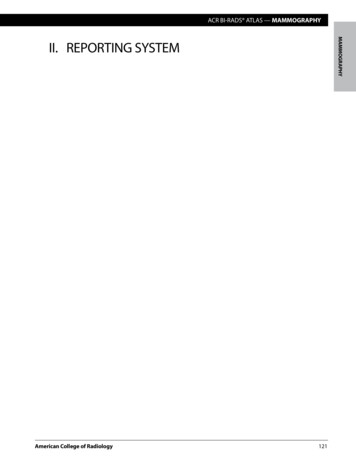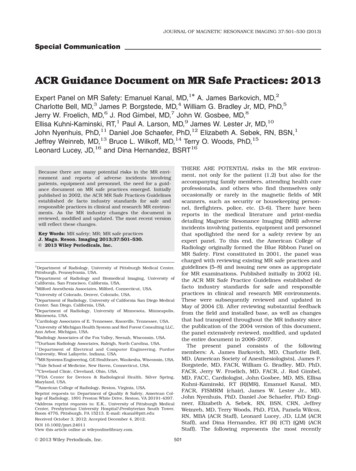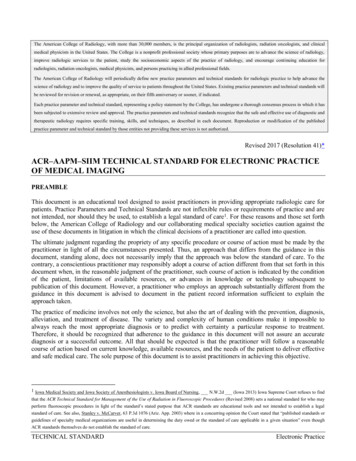
Transcription
The American College of Radiology, with more than 30,000 members, is the principal organization of radiologists, radiation oncologists, and clinicalmedical physicists in the United States. The College is a nonprofit professional society whose primary purposes are to advance the science of radiology,improve radiologic services to the patient, study the socioeconomic aspects of the practice of radiology, and encourage continuing education forradiologists, radiation oncologists, medical physicists, and persons practicing in allied professional fields.The American College of Radiology will periodically define new practice parameters and technical standards for radiologic practice to help advance thescience of radiology and to improve the quality of service to patients throughout the United States. Existing practice parameters and technical standards willbe reviewed for revision or renewal, as appropriate, on their fifth anniversary or sooner, if indicated.Each practice parameter and technical standard, representing a policy statement by the College, has undergone a thorough consensus process in which it hasbeen subjected to extensive review and approval. The practice parameters and technical standards recognize that the safe and effective use of diagnostic andtherapeutic radiology requires specific training, skills, and techniques, as described in each document. Reproduction or modification of the publishedpractice parameter and technical standard by those entities not providing these services is not authorized.Revised 2017 (Resolution 41)*ACR–AAPM–SIIM TECHNICAL STANDARD FOR ELECTRONIC PRACTICEOF MEDICAL IMAGINGPREAMBLEThis document is an educational tool designed to assist practitioners in providing appropriate radiologic care forpatients. Practice Parameters and Technical Standards are not inflexible rules or requirements of practice and arenot intended, nor should they be used, to establish a legal standard of care1. For these reasons and those set forthbelow, the American College of Radiology and our collaborating medical specialty societies caution against theuse of these documents in litigation in which the clinical decisions of a practitioner are called into question.The ultimate judgment regarding the propriety of any specific procedure or course of action must be made by thepractitioner in light of all the circumstances presented. Thus, an approach that differs from the guidance in thisdocument, standing alone, does not necessarily imply that the approach was below the standard of care. To thecontrary, a conscientious practitioner may responsibly adopt a course of action different from that set forth in thisdocument when, in the reasonable judgment of the practitioner, such course of action is indicated by the conditionof the patient, limitations of available resources, or advances in knowledge or technology subsequent topublication of this document. However, a practitioner who employs an approach substantially different from theguidance in this document is advised to document in the patient record information sufficient to explain theapproach taken.The practice of medicine involves not only the science, but also the art of dealing with the prevention, diagnosis,alleviation, and treatment of disease. The variety and complexity of human conditions make it impossible toalways reach the most appropriate diagnosis or to predict with certainty a particular response to treatment.Therefore, it should be recognized that adherence to the guidance in this document will not assure an accuratediagnosis or a successful outcome. All that should be expected is that the practitioner will follow a reasonablecourse of action based on current knowledge, available resources, and the needs of the patient to deliver effectiveand safe medical care. The sole purpose of this document is to assist practitioners in achieving this objective.1 Iowa Medical Society and Iowa Society of Anesthesiologists v. Iowa Board of Nursing, N.W.2d (Iowa 2013) Iowa Supreme Court refuses to findthat the ACR Technical Standard for Management of the Use of Radiation in Fluoroscopic Procedures (Revised 2008) sets a national standard for who mayperform fluoroscopic procedures in light of the standard’s stated purpose that ACR standards are educational tools and not intended to establish a legalstandard of care. See also, Stanley v. McCarver, 63 P.3d 1076 (Ariz. App. 2003) where in a concurring opinion the Court stated that “published standards orguidelines of specialty medical organizations are useful in determining the duty owed or the standard of care applicable in a given situation” even thoughACR standards themselves do not establish the standard of care.TECHNICAL STANDARDElectronic Practice
I.INTRODUCTIONThis technical standard has been revised by the American College of Radiology (ACR), the American Associationof Physicists in Medicine (AAPM), and the Society for Imaging Informatics in Medicine (SIIM).For the purpose of this technical standard, the images referred to are those that diagnostic radiologists wouldnormally interpret, including transmission projection and cross-sectional x-ray images, ionizing radiationemission images, and images from ultrasound and magnetic resonance modalities. Research, nonhuman, andvisible light images (such as dermatologic, histopathologic, or endoscopic images) are out of scope, though manyof the same principles are applicable.Increasingly, medical imaging and patient information are being managed using digital data during acquisition,transmission, storage, display, interpretation, and consultation. The management of these data during each ofthese operations may have an impact on the quality of patient care.This technical standard is applicable to any system of digital image data management, from a single-modality orsingle-use system to a complete picture archiving and communication system (PACS) to the electronictransmission of patient medical images from one location to another for the purposes of interpretation and/orconsultation.It defines goals, qualifications of personnel, equipment guidelines, specifications of data manipulation andmanagement, and quality control and quality improvement procedures for the use of digital image data that shouldresult in high-quality radiological care. A glossary of commonly used terminology (Appendix A) and a referencelist are included.In all cases for which an ACR practice parameter or technical standard exists for the modality being used or thespecific examination being performed, that practice parameter or technical standard will continue to apply whendigital image data management systems are used.In general, digital mammography is outside the scope of this technical standard (see ACR–AAPM–SIIM PracticeParameter for Determinants of Image Quality in Digital Mammography [1]). However, given the constantevolution of display technology and quality control, this technical standard does make suggestions on those areasthat are not fully addressed in other technical standards or practice parameters.The goals of the electronic practice of medical imaging include, but are not limited to:1.2.Initial acquisition or generation and recording of accurately labeled and identified image dataTransmission of data to an appropriate storage medium from which it can be retrieved for display forformal interpretation, review, and consultation3. Retrieval of data from available prior imaging studies to be displayed for comparison with a current study4. Transmission of data to remote sites for consultation, review, or formal interpretation5. Appropriate compression of image data to facilitate transmission or storage, without loss of clinicallysignificant information6. Archiving of data to maintain accurate patient medical records in a form that:a. May be retrieved in a timely fashionb. Meets applicable facility, state, and federal regulationsc. Maintains patient confidentiality7. Promoting efficiency and quality improvement8. Providing interpretations of images, selection of key images, and/or annotated images to referringproviders9. Supporting telemedicine by making medical image consultations available in medical facilities withouton-site medical imaging support10. Providing supervision of off-site imaging studiesElectronic PracticeTECHNICAL STANDARD
11.12.13.14.Providing timely availability of medical images, image consultation, and image interpretation by:Facilitating medical image interpretations in on-call situationsProviding subspecialty support as neededEnhancing educational opportunities for practicing radiologists, as well as those radiologists currently intraining programs15. Minimizing the occurrence of poor image quality16. Providing/assuring data security and preventing data theft (“breach”), in accordance with ACR–AAPM–SIIM Practice Parameter for Electronic Medical Information Privacy and Security [2]Appropriate database management procedures applicable to all of the above should be in place.II.QUALIFICATIONS AND RESPONSIBILITIES OF PERSONNELQualified personnel trained in the examination to be performed must perform the imaging examination at thetransmitting site. In all cases this means a physician, and a licensed and/or registered radiologic technologist orradiation therapist. It is also strongly recommended that each site have a Qualified Medical Physicist and anImaging Informatics Professional as consultants.A.Physician1. Physicians using the image data management system for official interpretation2 should understand thebasic technology of image acquisition, transmission, manipulation, retrieval, and display, including thestrengths, weaknesses, and limitations in the use of the image viewing equipment. Where appropriate,the interpreting physician must be familiar with the principles of radiation protection, the hazards ofradiation, and radiation monitoring requirements as they apply to both patients and personnel. Thephysician performing the official interpretation must be responsible for the quality of the images beingreviewed and understand the elements of quality control of digital image management systems3.2. The physician must demonstrate qualifications as delineated in the appropriate ACR practice parameteror technical standard for the particular diagnostic modality being interpreted.3. The physician should have a working knowledge of those portions of the digital image chain fromacquisition to display that affect image quality and potential artifact production.B.Qualified Medical PhysicistA Qualified Medical Physicist is an individual who is competent to practice independently one or more of thesubfields in medical physics. The American College of Radiology considers certification, continuing education,and experience in the appropriate subfield(s) to demonstrate that an individual is competent to practice one ormore of the subfields in medical physics and to be a Qualified Medical Physicist. The ACR strongly recommendsthat the individual be certified in the appropriate subfield(s) by the American Board of Radiology (ABR), theCanadian College of Physics in Medicine, or by the American Board of Medical Physics (ABMP).A Qualified Medical Physicist should meet the ACR Practice Parameter for Continuing Medical Education(CME) (ACR Resolution 17, 1996 – revised in 2012, Resolution 42) and should include continuing education inradiation dosimetry, radiation protection, and equipment performance [3].The appropriate subfields of medical physics for this technical standard are Therapeutic Medical Physics,Diagnostic Medical Physics, and Nuclear Medical Physics. (Previous medical physics certification categories2The ACR Medical Legal Committee defines official interpretation as that written report (and any supplements or amendments thereto) that attach to thepatient’s permanent record. In health care facilities with a privilege delineation system, such a written report is prepared only by a qualified physician whohas been granted specific delineated clinical privileges for that purpose by the facility’s governing body upon the recommendation of the medical staff.3The ACR Rules of Ethics state: “It is proper for a diagnostic radiologist to provide a consultative opinion on radiographs and other images regardless oftheir origin. A diagnostic radiologist should regularly interpret radiographs and other images only when the radiologist reasonably participates in the qualityof medical imaging, utilization review, and matters of policy which affect the quality of patient care.”TECHNICAL STANDARDElectronic Practice
including Radiological Physics, Therapeutic Radiological Physics, Medical Nuclear Physics, DiagnosticRadiological Physics, and Diagnostic Imaging Physics are also acceptable.)C.Registered Radiologist AssistantA registered radiologist assistant is an advanced level radiographer who is certified and registered as a radiologistassistant by the American Registry of Radiologic Technologists (ARRT) after having successfully completed anadvanced academic program encompassing an ACR/ASRT (American Society of Radiologic Technologists)radiologist assistant curriculum and a radiologist-directed clinical preceptorship. Under radiologist supervision,the radiologist assistant may perform patient assessment, patient management and selected examinations asdelineated in the Joint Policy Statement of the ACR and the ASRT titled “Radiologist Assistant: Roles andResponsibilities” and as allowed by state law. The radiologist assistant transmits to the supervising radiologiststhose observations that have a bearing on diagnosis. Performance of diagnostic interpretations remains outside thescope of practice of the radiologist assistant. (ACR Resolution 34, adopted in 2006)D.Radiologic TechnologistSee the ACR–SPR Practice Parameter for General Radiography [4]. Additional specific qualifications andresponsibilities include:1. The individual must meet the qualification requirements of any existing ACR practice parameter ortechnical standard for acquisition of a particular examination.2. He or she must be trained to properly operate those portions of the image data management system withwhich he or she must routinely interact. This training should include as appropriate:a. Image acquisition technologyb. Image processing protocolsc. Proper selection of examination specific options.d. Image evaluatione. Radiation dose indicatorsf. Patient safety procedures3. The technologist must:a. Be certified by the appropriate registry and/or possess unrestricted state licensure.b. Meet the qualification requirements of any existing ACR practice parameter or technical standardfor acquisition of a particular examination.c. Be trained to properly operate those portions of the image data management system with which heor she must routinely interact. This training should include as appropriate:i.Image acquisition technologyii.Image processing protocolsiii.Proper selection of examination specific options.iv.Image evaluationv.Radiation dose indicatorsE.Imaging Informatics ProfessionalThe Imaging Informatics Professional should be qualified to assess problems and provide input to solutions, toinitiate repairs, and to coordinate system-wide maintenance programs that will assure sustainable high imagequality and system functioning. The responsibilities and experience of an Imaging Informatics Professionalinclude:1. Maintenance of the network for all informatics systems, eg, radiology information system (RIS), PACS,speech recognition systems, computer servers and desktops.Electronic PracticeTECHNICAL STANDARD
2. Maintenance of the integrity and security of systems to ensure continuous and accurate operation of theinformatics systems.3. Coordination of the interaction/functionality of all data entry and management systems with thenecessary radiology applications, programs and databases.4. Knowledge of computer systems using common operating systems (Windows, Unix/Linux, Mac), datacommunications standards and equipment, network protocols, database management, internet protocols,and systems analysis methods and design.A Qualified Imaging Informatics Professional is an individual who is competent to practice independently in theareas of informatics listed above and discussed in the section on Informatics Workflow. He or she should have aminimum of a bachelor’s degree in computer science or equivalent, and continuing education and experience inimaging informatics to demonstrate that an individual is competent to practice as an Imaging InformaticsProfessional. Certification through the American Board of Imaging Informatics (ABII) can be used as validationof an individual’s qualification as a Qualified Imaging Informatics Professional.III.EQUIPMENT SPECIFICATIONSSpecifications for equipment used in digital image data management will vary depending on the application andthe individual facility’s needs, but in all cases it should provide image quality and availability appropriate to theclinical needs whether that need be official interpretation or secondary review. The equipment must also becapable of maintaining the security of patient information in accordance with the Health Insurance Portability andAccountability Act (HIPAA).Compliance with the Digital Imaging and Communications in Medicine (DICOM) standard, the Integrating theHealthcare Enterprise (IHE) Radiology Technical Framework, and, where applicable, the IHE-RadiationOncology Technical Framework (IHE-RO) is strongly recommended for all new equipment acquisitions, andconsideration of periodic upgrades incorporating the expanding features of that standard should be part of theongoing quality control program.A.Acquisition or DigitizationInitial image acquisition should be performed in accordance with the appropriate ACR modality or examinationpractice parameter or technical standard.1. Direct image captureThe images data set acquired by the digital modality in the full spatial resolution (image matrix size)and pixel bit depth should be transferred to the image management system. It is recommended that theDICOM standard be used.2. Scanned radiographic filmsAlthough films from prior patient studies may be digitized using modern film scanning systems,scanned films should be used only when digital image transfer is not available.Films from prior patient studies may be digitized using modern film scanning systems. When used, thepixel pitch of the scanner should be small enough to capture the limiting resolution of the film. Forgeneral purpose radiographic films, a pitch of less than 200 µm (2.5 cycles/mm limiting resolution)should be used. For high resolution film or mammography, a pitch of less than 100 µm (5.0 cycles/mmlimiting resolution) should be used. The scanner should be capable of recording film optical densitiesup to at least 3.2 for general purpose radiographs and 4.0 for high resolution radiographs andmammograms. The digitization should have at least 12 bits of precision (0 to 4,095) and produce eitherTECHNICAL STANDARDElectronic Practice
DICOM presentation values or values proportional to film density. Caution should be exercised whenusing photographic cameras because of their inherent distortion and possible optical artifacts.3. Video digitizer acquisitionsTraditional fluoroscopy systems have used video recording cameras to acquire images from the outputphosphor of an image intensifier. Recordings may be of individual spot exposures, pulsed fluoroscopicsequences, or continuous fluoroscopic frames. Analog video cameras produce a time varying voltagesignal corresponding to a raster scan of the image. Analog to digital conversion systems are used toconvert these signals to digital images formatted according to the DICOM standard. These systems aresusceptible to degraded quality due to analog signal noise, timing, and drift. When used, the imagequality should be closely monitored. In general, the use of digital recording cameras with imageintensifiers or direct digital fluoroscopy panels is preferred.4. General requirementsa. At the time of patient imaging, the imaging modality must have capabilities for capturingdemographic as well as imaging information such as accession number, patient name, identificationnumber, date and time of examination, name of facility or institution, type of examination, patientor anatomic part orientation (eg, right, left, superior, inferior), amount and method of datacompression, and total number of images acquired in the study. (In some cases the total number ofimages may not be known if the modality sends images as they are acquired.) It is beneficial tohave the capability for capturing imaging technique factors, including patient dose parameters,applicable to the imaging modality. This information must be associated with the images whentransmitted with a modality-specific information object descriptor (IOD). These fields should beformatted according to the DICOM standard. It is desirable to obtain this information using theDICOM modality work list services that communicate the correct information electronically.b. The ability to capture the patient date of birth, sex, indications for the examination, and a briefpatient history is desirable.B.CompressionCompression may be defined as mathematically reversible (lossless) or irreversible (lossy). Reversiblecompression may always be used, since by definition there is no impact on the image. Irreversible compressionmay be used to reduce transmission time or storage space only if the quality of the result is sufficient to reliablyperform the clinical task. The type of body part, the modality, and the objective of the study will determine theamount of compression that can be tolerated.The term “diagnostically acceptable irreversible compression” (DAIC) refers to mathematically irreversiblecompression that does not affect a particular diagnostic task [5]. DAIC may be used under the direction of aqualified physician with no reduction in clinical diagnostic performance by either the primary image interpreter ordecision makers reviewing the images. From a practical perspective, this means that any artifacts generated by thecompression scheme should not be perceptible by the human viewer or are at such a low level that they do notinterfere with interpretation.The ACR and this technical standard make no general statement on the type or amount of compression that isappropriate to any particular modality, disease, or clinical application to achieve the diagnostically acceptablegoal. The scientific literature and other national guidelines may assist the responsible physician in choosingappropriate types and amounts of compression, weighing the risk of degraded performance against the benefits ofreduced storage space or transmission time. The type and amount of compression applied to different imagingstudies transmitted and stored by the system should be initially selected and periodically reviewed by theresponsible physician to ensure appropriate clinical image quality, always considering that it may be difficult toevaluate the impact on observer performance objectively and reliably [6].Electronic PracticeTECHNICAL STANDARD
If reversible or irreversible compression is used, only algorithms defined by the DICOM standard such as JointPhotographic Experts Group (JPEG), JPEG-LS, JPEG-2000, or MPEG should be used, since images encodedwith proprietary and nonstandard compression schemes reduce interoperability, and decompression followed byrecompression with a different irreversible scheme (such as during migration of data) will result in significantimage quality degradation [5]. The DICOM standard does not recommend or approve any particular compressionscheme for any particular modality, image type, or clinical application.The U.S. Food and Drug Administration (FDA) requires that when an image is displayed it be labeled with amessage stating if irreversible compression has been applied and with approximately what compression ratio(and/or quality factor) [7]. In addition, the name or type of compression scheme used (for standard schemes suchas JPEG, JPEG 2000, etc) should also be displayed, since this affects the interpretation of the impact of thecompression. The DICOM standard defines specific fields for the encoding of this information and requires itspersistence even after the image has been decompressed.The FDA does not allow irreversible compression of digital mammograms for retention, transmission, or finalinterpretation, though irreversibly compressed images from prior studies may be used for comparison purposes, ifdeemed of acceptable quality by the interpreting physician [8]. For other modalities, the FDA does not restrict theuse of compression, but it does require manufacturers of devices that use irreversible compression to submit dataon the impact of the compression on quantitative metrics of image quality (such as peak signal-to-noise ratio(pSNR) [7]. The responsible physician, working with the Qualified Medical Physicist as appropriate, isresponsible for ensuring that the image quality is sufficient to achieve a diagnostically acceptable goal.C.TransmissionThe environment in which the studies are to be transmitted will determine the type and specifications of thetransmission devices used. In all cases, for official interpretation, the digital data received at the receiving end ofany transmission must have no loss of clinically significant information. The transmission system should have abandwidth commensurate with expected volumes to ensure images are delivered in a timely fashion. Thetransmission system must have adequate error-checking capability. Only the appropriate modality-specificDICOM service-object pair (SOP) classes should be used for transmission and storage.D.DisplayThe consistent presentation of images on workstations is essential for electronic imaging operations. Images seenby technologists during acquisition, by radiologists during interpretation, and by physicians as a part of patientcare should have similar appearance. The spatial and contrast resolution of images displayed for interpretation isparticularly important. The presentation of images is influenced by workstation software, graphic controllers, anddisplay devices.1. Workstation characteristicsa. Workstation displays can be separated into different categories determined by utilization. There arediagnostic displays, often referred to as primary interpretation displays, and non-diagnosticdisplays, often referred to as secondary displays, which include modality displays.b. Graphic bit depth: The operating systems of most workstations manage images with red, green, andblue channels having 8 bits (256 values). The number of available gray levels where the red, green,and blue values are equal is thus 256. Systems with increased bit depth, such as 30-bit graphics with10 bits per channel, require support from the operating system, workstation software, graphics card,and monitor. Although subtle differences between 8-bit and 10-bit systems can be demonstratedusing test patterns, no evidence has been found to date that diagnostic interpretations are affectedby the use of higher than 8-bit systems.TECHNICAL STANDARDElectronic Practice
c. Display technology: Nearly all workstation displays now use LCD or organic light emitting diode(OLED) panels. Their discrete pixels offer excellent resolution without distortion. The flat panelsurfaces are able to absorb ambient light to minimize reflections and glare. However, lower costLCD units using twisted nematic (TN) pixel structures severely alter image brightness, contrast, andcolor in relation to viewing angle. TN LCD devices should not be used for medical image viewing.Several advanced LCD pixel structures are now available to provide improved viewing angleperformance (vertical alignment (VA), in-plane switching (IPS), plane to line structure (PLS), andmulti-domain structures). The viewing angle characteristics of any LCD device should be evaluatedprior to purchase.d. Graphic interface: LCD and OLED devices are inherently digital with an internal buffer storing thedata for each pixel in the rows and columns of the device. The interface between the graphiccontroller and the LCD device should transfer the image data using a digital format such as DVI-D(either single-link or dual-link) or Display Port. For optimal resolution, the graphic controllerdevice driver should always be set to the native rows and columns of the LCD device. An analogvideo interface signal such as VGA or DVI-A is strongly discouraged since the digital to analogconversion in the graphic controller and the analog to digital conversion in the LCD device canintroduce image degradation.e. Image presentation size: The rows and columns of the displayed image are typically different thanthe rows and columns of the acquired image. The application software working in conjunction withthe graphic controller interpolates from the acquired image data to get the displayed image data.For optimal image resolution, the interpolation of each displayed pixel, whether up-sampling ordown-sampling, should consider more than the closest 4 acquired pixel values. Cubic spline andcubic polynomial interpolation algorithms are commonly used for high quality interpolation withthe graphic controller providing acceleration so that images are presented with negligible delay.When down-sampling noisy images, the extended region considered in the interpolation also helpsreduce noise in the presentation.f.Presentation support features: The application software used to select and present imaging studiesshould provide features to allow rapid and easy review or interpretation of a study.i.Hanging protocols that address the selection of image series and display format should beflexible and tailored to user preferences with proper labeling and orientation of images.ii.Fast and easy navigation between new and old studies should be
TECHNICAL STANDARD Electronic Practice The American College of Radiology, with more than 30,000 members, is the principal organization of radiologists, radiation oncologists, and clinical medical physicists in the United States. The College is a nonprofit professional society whose primary purposes are to advance the science of radiology,
